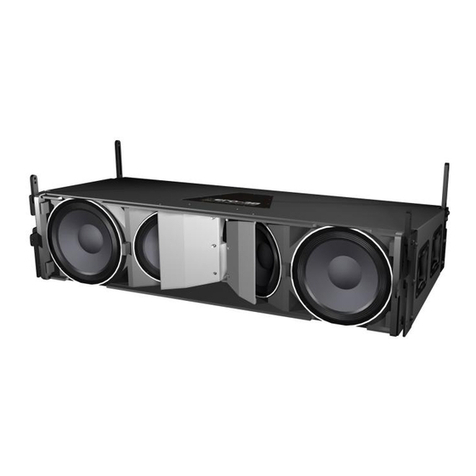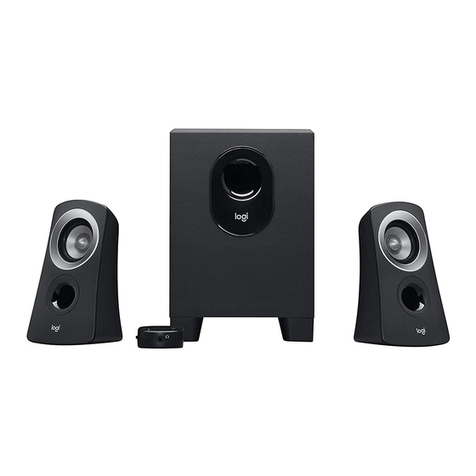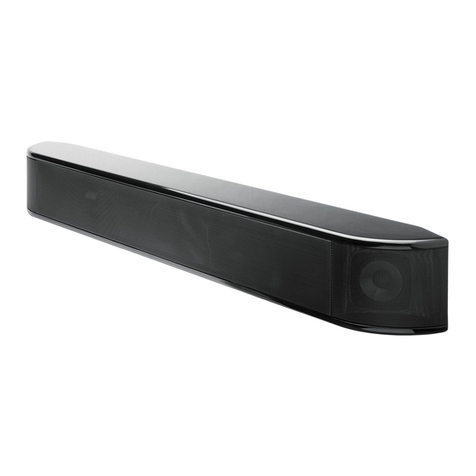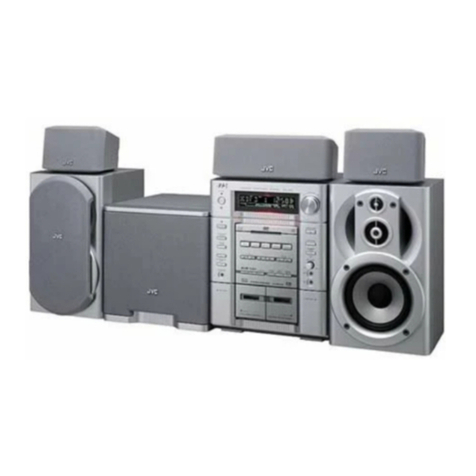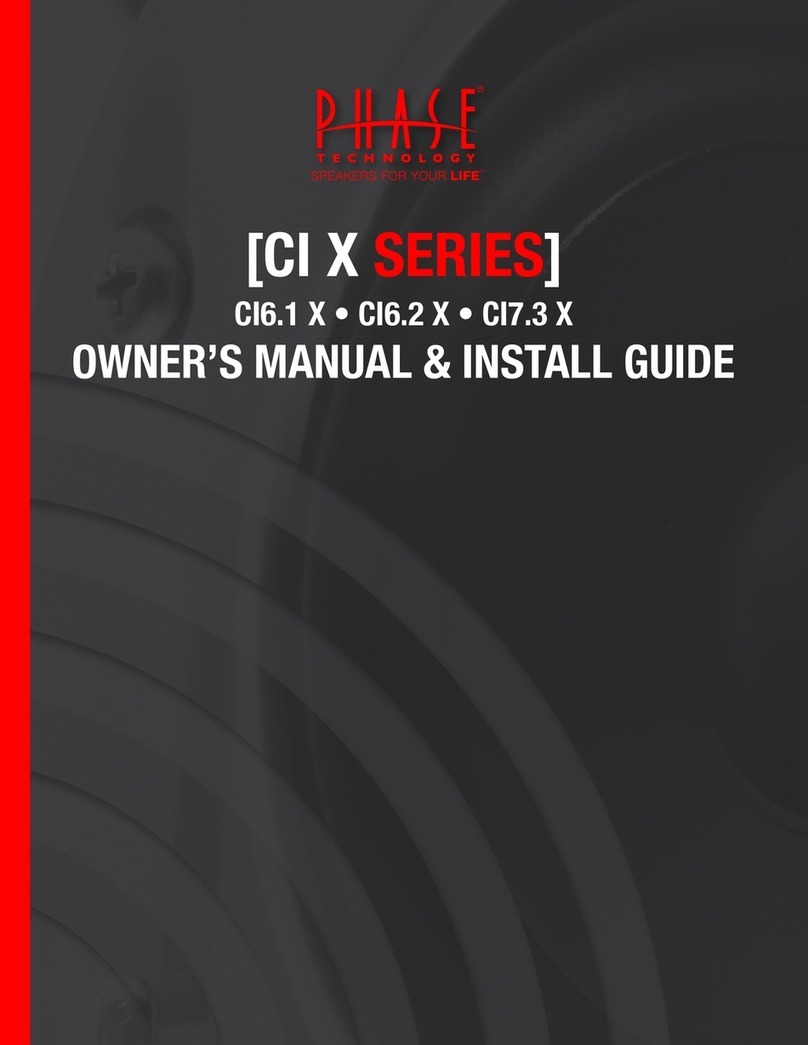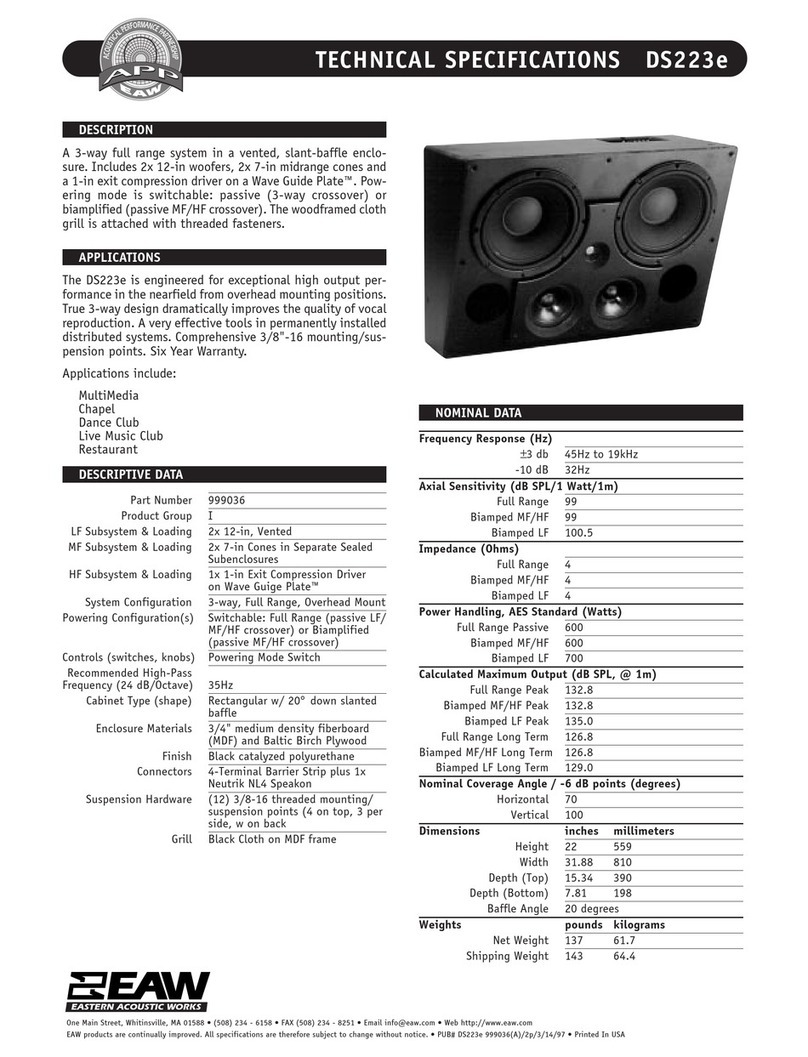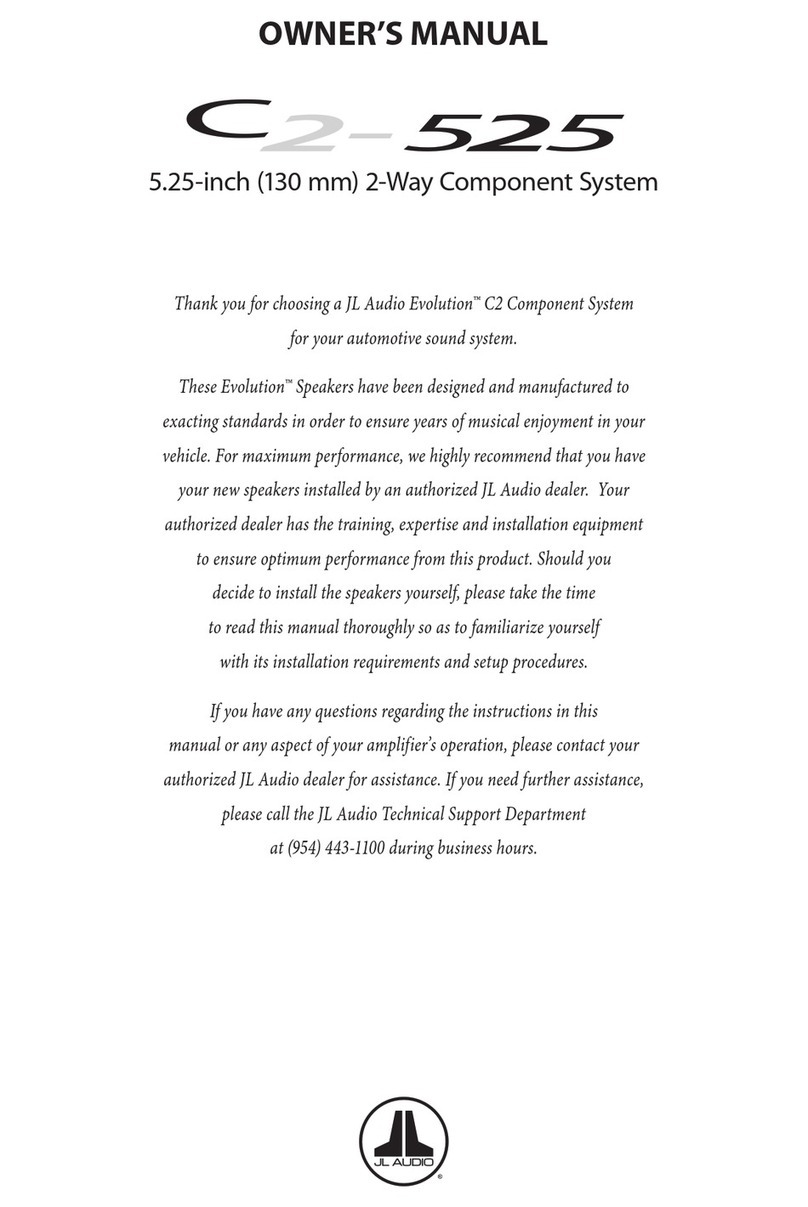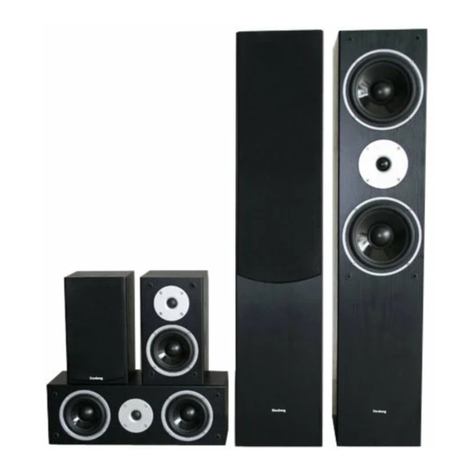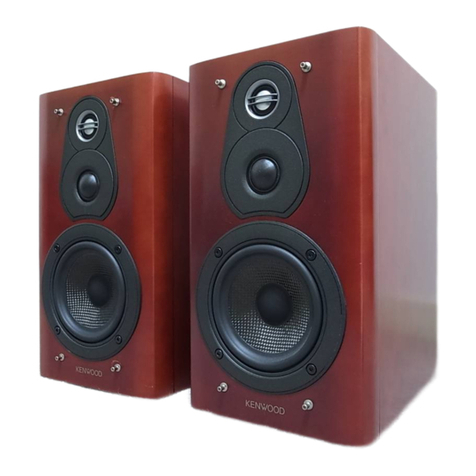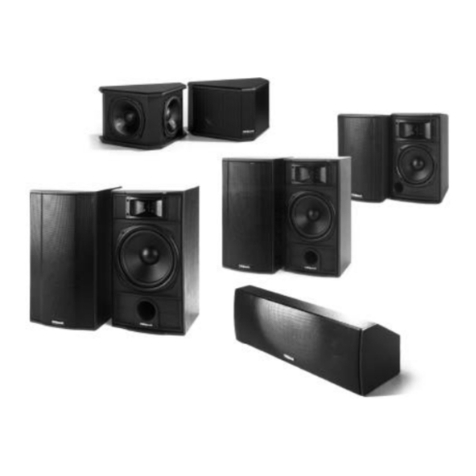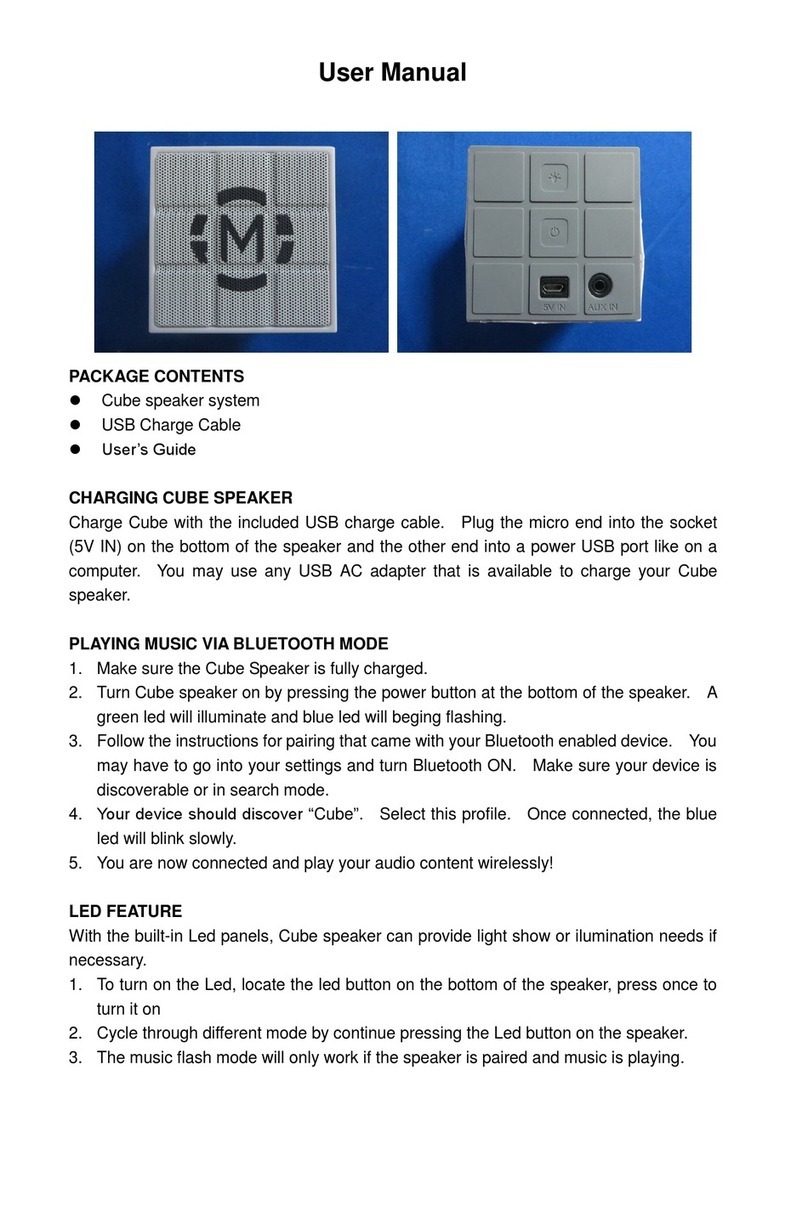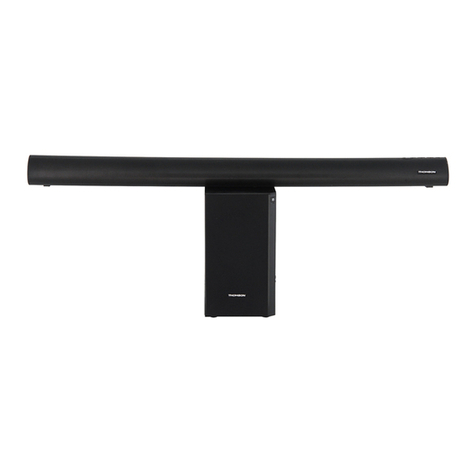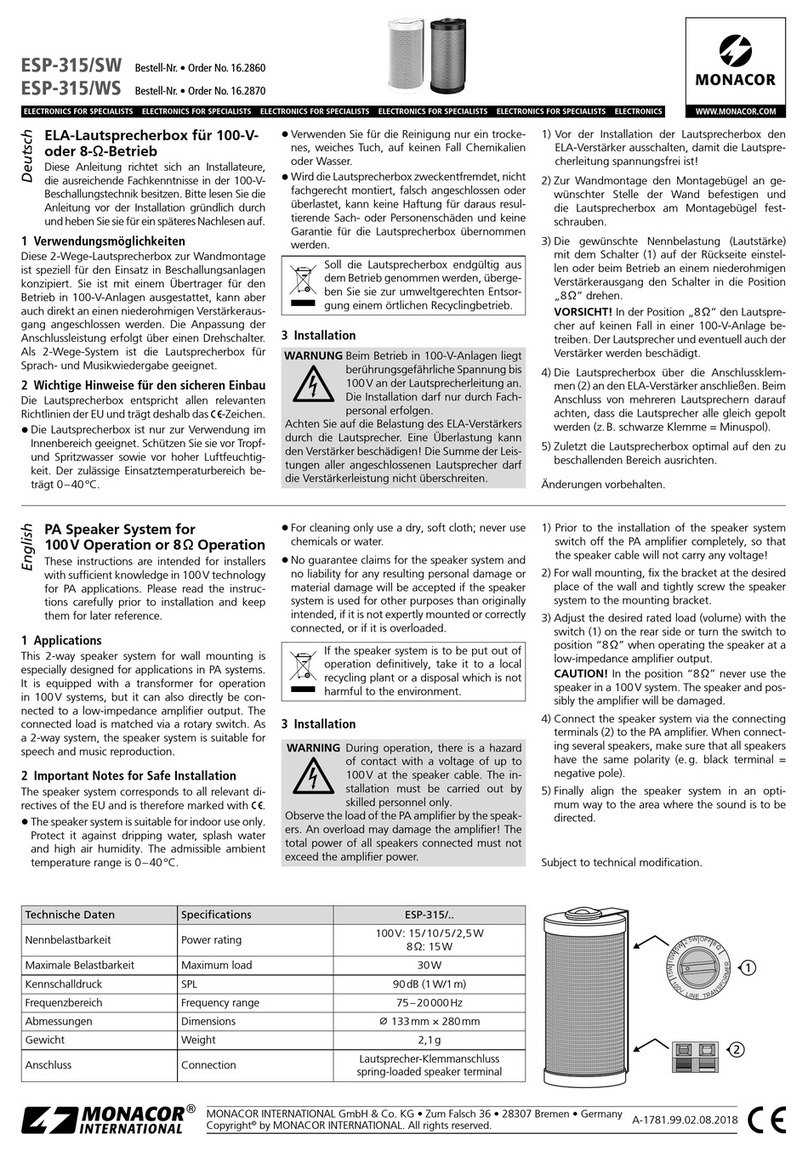D.A.S. ST Series User manual

R+ St
series
MANUAL DEL USUARIO / USER’S GUIDE
www.audiovias.com

Precauciones de Seguridad
El signo de exclamación
dentro de un triángulo indica la
existencia de importantes
instrucciones de operación y
mantenimiento en la
documentación que acompaña
al producto.
El doble cuadrado indica
equipo de Clase 2.
No exponga este equipo a
lluvia o humedad.
No emplace altavoces en
proximidad a equipos
sensibles a campos
magnéticos, tales como
monitores de televisión o
material magnético de
almacenamiento de datos.
No existen partes ajustables
por el usuario en el interior de
este equipo.
Altura máxima de seguridad
desde el suelo a la base de la
caja montada sobre trípode
modelo TRD-2, pies a su
máxima extensión:
R-112 112 cm
R-115 99 cm
ST-015 115 cm
ST-15 112 cm
ST-32 107 cm
El resto de los modelos no se
pueden montar en trípode.
Safety Precautions
The exclamation point inside an
equilateral triangle is intended to
alert the users to the presence of
important operating and
maintenance (servicing)
instructions in the literature
accompanying the product.
The double square indicates
Class 2 device.
Do not expose this device to rain
or moisture.
Do not place loudspeakers in
proximity to devices sensitive to
magnetic fields such as
television monitors or data
storage magnetic material.
No user serviceable parts inside.
Maximum safety height from
floor to bottom of enclosure
when mounting on a TRD-2
tripod with legs fully open:
R-112 112 cm
R-115 99 cm
ST-015 115 cm
ST-15 112 cm
ST-32 107 cm
The rest of the models are not
tripod mountable.
Sicherheitshinweise
Das Ausrufezeichen im Dreieck
weist auf inhaltlich besonders
wichtige Erklärungen des
nebenstehenden Textes hin.
Das doppelte Viereck bedeutet
daß es sich um ein Gerät der
Klasse 2 handelt.
Dieses Gerät nicht dem Regen
oder extremer Feuchtigkeit
aussetzen.
Plazieren Sie Lautsprecher nicht
in der Nähe von Geräten die
empfindlich auf magnetische
Felder sind (z.B.:
Fernsehmonitore, magnetische
Datenmedien).
Es sind keine vom Anwender
einstellbaren Teile im Gerät
enthalten.
Maximale Höhe des Unterteils
der Box bis zum Boden, wenn
auf dem Ständer TRD-2, mit voll
aufgeklappten Gestell montiert:
R-112 112 cm
R-115 99 cm
ST-015 115 cm
ST-15 112 cm
ST-32 107 cm
Restliche Typen können nicht auf
Lautsprecherstative montiert
werden.
Règles de Sécurité
Le point d'exclamation dans un
triangle équilatéral alerte signale
la présence d'informations
importantes de fonctionnement
et de maintenance dans le
manuel qui accompagne le
produit.
Le double carré circonscrit
indique un appareil de Classe 2.
Ne pas exposer l'appareil à la
pluie ou à l'humidité.
Ne pas disposer ces enceintes à
proximité d'appareils ou supports
sensibles aux champs
magnétiques tels que moniteurs
vidéo, télévision ou diskettes et
cassettes vidéo/audio.
Aucune pièce est réparable par
l'utilisateur à l´interieur.
Distance maximum du sol à la
base des enceintes montées sur
le tripode TRD-2 à ouverture
maxi des pieds:
R-112 112 cm
R-115 99 cm
ST-015 115 cm
ST-15 112 cm
ST-32 107 cm
Les autres modeles ne sont pas
montables sur tripode.
www.audiovias.com

Series R y ST. Manual de Usuario /
R and ST Series. User's Manual
3
ÍNDICE
Precauciones de seguridad
1. Introducción
1.1 Características de las series
1.2 Características de los modelos
2. Conexiones
2.1 Cableado
2.2 Conexiones básicas
3. Montaje y colocación
3.1 Colocación
3.2 Utilización sobre trípode
3.3 Utilización sobre SUB-18R / ST-18 con TRD-4
3.4 Utilización como monitor de escenario
3.5 Resistencia a la intemperie
4. Colgado
4.1 Introducción
4.2 Colgado con cáncamos
4.3 Colgado con AncraTrack
4.4 Formaciones
5. Configuraciones de sistemas
6. Ejemplos de aplicaciones
7. Uso
8. Especificaciones
9. Dibujos de línea
10. Apéndices
10.1 Conexiones de línea : no-balanceadas y balanceadas
10.2 Datos de contacto de fabricantes de herrajes para
colgado
CONTENTS
Safety Precautions
1. Introduction
1.1 Series' Features
1.2 Models' Features
2. Connections
2.1 Wiring
2.2 Basic connection
3. Mounting and placement
3.1 Placement
3.2 Tripod use
3.3 Use on SUB-18R / ST-18 with TRD-4
3.4 Stage monitor use
3.5 Weather resistance
4. Flying
4.1 Introduction
4.2 Flying with eyebolts
4.3 Flying with AncraTrack
4.4 Arraying
5. System configurations
6. Application examples
7. Use
8. Specifications
9. Line drawings
10 Appendices
10.1 Balanced and unbalanced line connections
10.2 Contact details for flying hardware manufacturers
www.audiovias.com

Series R y ST. Manual de Usuario /
R and ST Series. User's Manual
42
1. INTRODUCTION
Thank you for purchasing a D.A.S. product. The ST and R
series represent more than 30 years of expertise in transducer
and enclosure design, achieving a series of systems that
utilise the most advanced sound reinforcement technology to
deliver outstanding audio performance and maximum
reliability.
Engineered from "real world" experience in system design,
with exceptional efficiency, pattern control and intelligibility,
these series provide designers with the primary tools to solve
the problems of sound reinforcement.
For those systems that require enclosures featuring different
configurations or smaller size, ST and R series may be
combined with other series from D.A.S. For instance, a main
theatre system based around R or ST could use a compact 8”
model from our Dynamics Series for distributed fills.
This manual contains the required information to make the
best use of the system you have purchased. Please take the
time to read it.
Our Web site at www.dasaudio.com contains further support
information such as enclosure and system drawings, data for
modelling software, architectural specifications and
specification sheets.
1.1 Series' features
• High frequency compression drivers with pure titanium
diaphragms and Neodymium magnet structures (except
models with small format HF drivers, which use ferrite
magnets)
• Rugged enclosures manufactured from Finnish Wisa®
plywood for rigidity and durability (except SUB-18R, MDF
wood)
• Bar handles or hand locations for easy transport
• Finished in catalysed polyurethane black paint that
provides protection against the elements and abrasion.
The finish may be painted on to complement the decor
• Polyamide powder coated front grilles prevent corrosion
and maintain good looks. On the ST series, the grilles are
covered with acoustically transparent cloth for protection
against rain, dust and dirt
• Dual NL4 or NL8 (model dependent) Speakon input/output
connectors
• Tripod mountable (models for which size allows)
• Flying points (eyebolt based or AncraTrack/eyebolt
according to model). Except ST-32, ST-015 and SUB-18R.
• Optional flying accessories
www.audiovias.com

Series R y ST. Manual de Usuario /
R and ST Series. User's Manual
43
1.2 Models' features
PRODUCT FEATURES APPLICATIONS
R-112
• Two-way full-range system
• Trapezoidal enclosure
• Tripod socket
• Passive (full-range) use
• 1 x 12" woofer
• Small format compression driver with ASC protection
• Medium power
• Medium sensitivity
• Short / medium throw
• Sound reinforcement for fixed installations. Pubs,
restaurants, discos, indoor sport arenas. Stand-
alone or subwoofer reinforced
• Secondary area fills
R-115
• Two-way full-range system
• Trapezoidal enclosure
• Tripod socket
• Passive (full-range) use
• 1 x 15" woofer
• Small format compression driver with ASC protection
• Medium power
• Medium sensitivity
• Short / medium throw
• Sound reinforcement for fixed installations. Pubs,
restaurants, discos, indoor sport arenas
• Secondary area fills.
R-214
• Two-way full-range system
• Trapezoidal enclosure
• Passive (full-range) use
• 2 x 15" woofer
• Small format compression driver with ASC protection
• Medium / high power
• Medium sensitivity
• Short / medium throw
• Sound reinforcement for fixed installations.
Pubs, live music bars
• Medium power side-fill
R-212
• Two-way mid-high / full-range system
• Trapezoidal enclosure
• Bi-amplified and passive (full-range) modes
• 2 x 12" mid-high speakers
• Neodymium magnet large format compression driver
• High power
• Medium / high sensitivity
• Medium throw
• Rotatable horn
• Sound reinforcement for fixed installations. Live
sound, theatres, discos. Always use sub-woofer
complement
R-215
• Two-way full-range system
• Trapezoidal enclosure
• Bi-amplified and passive (full-range) modes
• 2 x 15" woofers
• Neodymium magnet large format compression driver
• High power
• Medium / high sensitivity
• Medium / long throw
• Transport wheels
• Sound reinforcement for fixed installations and
mobile use. Live sound, theatres, discos. Stand-
alone or sub-woofer reinforced
• Side-fill
www.audiovias.com

Series R y ST. Manual de Usuario /
R and ST Series. User's Manual
44
PRODUCT FEATURES APPLICATIONS
SUB-18R
• Sub-woofer system
• Rectangular enclosure
• Tripod socket for mid-high enclosures
• 1 x 18" woofer
• Medium power
• Medium sensitivity
• Low frequency reinforcement for fixed
installations. Pubs, bands, theatres
SUB-218
• Sub-woofer system
• Rectangular enclosure
• 2 x 18" woofers
• High power
• Medium sensitivity
• Low frequency reinforcement for fixed
installations and mobile applications. Live
sound, theatres, discos
ST-015
• Two-way mid-high / full-range system
• Tripod socket
• Passive (full-range) use
• 1 x 15" mid-high speaker
• Neodymium magnet medium format compression
driver
• Medium power
• Medium sensitivity
• Short / medium throw
• Left and right (shown) versions
• Low-profile stage monitor wedge
ST-15
• Two-way mid-high / full-range system
• Low profile multi-angle enclosure
• Tripod socket
• Bi-amplified and passive (full-range) modes
• 1 x 15" mid-high speaker
• Neodymium magnet large format compression driver
• Medium / high power
• Medium sensitivity
• Medium throw
• Rotatable horn
• Sound reinforcement for fixed installations and
mobile applications. Theatres, discos. Always
use sub-woofer complement
• High power low profile system for low ceiling
applications
• High power stage monitor wedge
ST-32
• Two-way full-range system
• Tripod socket
• Passive (full-range) use
• 1 x 15" coaxial speaker
• Small format compression driver with ASC protection
• Medium power
• Medium sensitivity
• Short / medium throw
• Uniform directivity helps fight feedback
• Stage monitor wedge
• Multi-purpose system
www.audiovias.com

Series R y ST. Manual de Usuario /
R and ST Series. User's Manual
45
PRODUCT FEATURES APPLICATIONS
ST-110
• Two-way mid-high system
• Trapezoidal enclosure
• Passive use
• 1 x 10" mid-range speaker
• Neodymium magnet large format compression driver
• Medium / high power
• High sensitivity
• Medium / long throw
• Sound reinforcement for fixed installations and
mobile applications. Touring, large scale discos.
Always use sub-woofer complement
• Vocal system for speech applications and
background music in large spaces
ST-112
• Two-way mid-high system
• Trapezoidal enclosure
• Bi-amplified use
• 1 x 12" mid-range speaker
• Neodymium magnet large format compression driver
• Medium / high power
• High sensitivity
• Medium / long throw
• Sound reinforcement for fixed installations and
mobile applications. Touring, large scale discos.
Use sub-woofer complement
• Vocal system for speech applications and
background music in large spaces
ST-215
• Two-way mid-high system
• Trapezoidal enclosure
• Bi-amplified use
• 2 x 15" mid-range speakers
• Neodymium magnet large format compression driver
• High power
• High sensitivity
• Long throw
• Transport wheels
• Sound reinforcement for fixed installations and
mobile applications. Touring. Use sub-woofer
complement
• Sound reinforcement in large spaces
ST-18
• Folded-horn sub-woofer system
• Rectangular enclosure
• Tripod socket for mid-high enclosures
• 1 x 18" woofer
• High power
• High sensitivity
• Low frequency reinforcement for fixed
installations and medium-sized mobile
applications. Pubs, bands
ST-218
• Folded-horn sub-woofer system
• Rectangular enclosure
• 2 x 18" woofers
• High power
• High sensitivity
• Transport wheels
• Low frequency reinforcement for fixed
installations and mobile applications. Live
sound, touring, discos
www.audiovias.com

Series R y ST. Manual de Usuario /
R and ST Series. User's Manual
46
2. CONNECTIONS
2.1 Wiring
R and ST series enclosures utilise two NL4 (four pin) or NL8
(eight pin) Neutrik Speakon connectors. These connectors are
specific for speaker use and allow a safe and professional
connection. Models ST-112, ST-215, ST-18 and ST-218 use
NL8, the rest use NL4. For plugging into an enclosure, insert
the male connector into any of the inputs and rotate it
clockwise. It will then lock into place and be ready for use.
The drawing illustrates the terminal arrangement detail:
The enclosures provide two
paralleled connectors. This
allows for easy loop through
from one speaker to the next.
Unused connector pins are
also paralleled. Both
connectors can be used as
either inputs or outputs.
To ensure quality sound and
minimum power loss, the
speaker cable needs to have
a large enough cross section
depending on the cable
length, number of speakers
per channel and speaker
impedance. The total
impedance for a number of
speakers in parallel is equal
to the impedance of one
divided by the number of
speakers. For instance, two
R-112 in parallel total 4 ohms
(8 ohms divided by 2 boxes
equal 4). It is particularly
important to use a large
enough gauge with those
speakers that carry deep
bass, such as ST-18/218,
SUB-18R/218 o R-215.
The tables show the minimum size for different runs of cable
and four or eight ohms connected per channel:
- Use the eight ohm table when connecting a single eight
ohm speaker per channel. For instance, one R-115 in each
channel of a stereo amplifier or the mid frequency band of an
ST-112,
- Use the four ohm table when connecting two eight ohm
speakers to an amplifier channel. For instance, two R-115
units in parallel. Also for one four ohm speaker per channel,
such as for one ST-218 per channel.
When connecting more than one speaker to an amplifier
channel there are two wiring options. The first is to run cable
from the amplifier's output terminals to each speaker. The
second is to connect the closest speaker to the amplifier and
then connect the two speakers together with a loop through
cable that has a Speakon (NL8 or NL4 according to the model)
connector on both ends. We'll be paralleling speakers in both
cases. The latter is the most common and practical option, the
former providing a higher damping factor.
Never use a total impedance load that is lower than the lowest
impedance that an amplifier will take. Virtually all professional
amplifiers will accept loads down to four ohms safely in stereo
mode. Many are rated for two ohm loads but often will run
into overheating protection when used this way, particularly in
high ambient temperature and high output power applications.
Never connect more speakers to an amplifier's channel than it
will take, i.e. do not load a channel with a total impedance that
is lower than the minimum load specified by the manufacturer.
Avoid series or series-parallel wiring schemes for ST and R
series products, since they degrade sound quality and thus we
do not recommend them for applications other than
background music, paging, or surround sound.
8 ohm per amplifier channel
Cable length Minimum cable thickness
metres feet mm² Gauge no. (AWG)
2,5 8 0,3 22
5 16 0,5 22
7,5 25 0,8 18
10 33 1,31 16
15 50 2,1 14
20 66 3,3 12
50 164 5,3 10
75 250 8,35 8
100 328 13,3 6
200 656 20,8 4
400 1312 33,3 2
4 ohm per amplifier channel
Cable length Minimum cable thickness
metres feet mm² Gauge no. (AWG)
2,5 8 0,8 18
5 16 1,31 16
7,5 25 2,1 14
10 33 3,3 12
15 50 5,3 10
20 66 5,3 10
50 164 13,3 6
75 250 20,8 4
100 328 33,3 2
200 656 52,9 0
400 1312 80,2 000
www.audiovias.com

Series R y ST. Manual de Usuario /
R and ST Series. User's Manual
47
2.2 Basic connection
This section provides information on the pin assignments and
basic set-up for the different enclosures. The "System
Configurations" section adds stereo system configurations
with or without sub-woofer reinforcement. The “Application
Examples” section adds complete application specific system
examples.
Some models, due to the complexities of their electronic
processing, require the indicated D.A.S. controller for the
system to run correctly. Others may use generic crossover
units with recommended settings, although the use of the
D.A.S. processors is recommended. In general, we stress the
importance of the use of the DAS processors, since they are
shipped with set energy balances and crossover frequencies,
and adjustments cannot be made that could endanger system
components. By using the DAS processors, we can ensure the
correctness of the sound and the reliability of the systems.
The following table shows the basic features of the DAS CT
controllers:
The following table shows the controller for each system with
or without subwoofer reinforcement.
Model
Stand-alone With subwoofer
reinforcement
(SUB-18R/218,
ST-18/218)
R-112 / R-115 / R-214 None CT-1
R-212 / R-215
in passive mode
None CT-1
R-212 / R-215
in active mode
CT-2000,
CT-1000
CT-2000,
CT-1000
ST-15
in passive mode
None CT-1
ST-15
in active mode
CT-1000 CT-1000
ST-015 / ST-32 None Not available
ST-110 Not available CT-1500
ST-112 Not available CT-1800
ST-215 CT-2000 CT-2000
If you wish to use a programmable digital processor, contact
your DAS distributor to get a list of set-up parameters for your
system.
R-112/115
Figures show the block diagram and basic set-up for models
R-112 and R-115. 300 to 400 watts of amplifier power are
recommended for the R-112, and 350 to 450 W for the R-115.
R-214
Figures show the block diagram and basic set-up for model R-
214.
R-212
Figures show the block diagram and basic set-up. A switch,
located at the input connector plate, allows to change
between passive (full-range) and bi-amplified use. In passive
use, the acoustical high frequency rolloff of the low frequency
section is used to crossover to the mid/high frequency
section, which utilises an equalised highpass filter network.
When using the system
in active (bi-amplified)
mode, use the D.A.S. CT-
2000 monophonic
electronic processor or a
24/dB octave electronic
crossover unit with the
crossover frequency set to 1200 Hz. We thoroughly
recommend the use of the D.A.S. CT-2000 (CT-1000 can also
be used for applications outside disco/club), since it is factory
shipped with appropriate crossover frequencies, which cannot
be accidentally modified.
R-215
Figures show the block diagram and basic set-up. A switch
located at the input connector plate, allows to change
between passive (full-range) and bi-amplified use. In passive
use, the acoustical high frequency rolloff of the low frequency
section is used to crossover to the mid/high frequency
section, which utilises an equalised highpass filter network.
When using the system in active (bi-amplified) mode, use the
D.A.S. CT-2000 monophonic electronic processor or a 24/dB
octave electronic crossover unit with the crossover frequency
set to 1200 Hz. We thoroughly recommend the use of the
D.A.S. CT-2000 (CT-1000 can also be used for applications
outside disco/club), since it is factory shipped with
appropriate crossover frequencies, which cannot be
accidentally modified.
Model CT-1 CT-1000 CT-1500 CT-1800 CT-2000
Type Stereo Mono
Modes Full range/2-way 2-way / 3-way 2-way 3-way 2-way / 3-way
Limiters --- Variable per way
Gain Controls Low Low-Mid-High Low-High Low-Mid-High
Xover freqs 100 Hz 1200 /
125, 1200 Hz
160 Hz 125, 1200 Hz 1200 /
125, 1200 Hz
www.audiovias.com

Series R y ST. Manual de Usuario /
R and ST Series. User's Manual
48
SUB-18R
Figures show the block diagram and basic set-up. The SUB-
18R is a bass unit for active systems, so an electronic
crossover will be required with a crossover frequency set in
the range from 80 to 160 Hz. One of such units, capable of
driving two way-active systems, is the D.A.S. CT-1, which
features a mid/high stereo output and a monophonic
subwoofer output with a crossover frequency of 100 Hz.
SUB-218
Figures show the block diagram and basic set-up. The SUB-
218 is a bass unit for active systems, so an electronic
crossover will be required with a crossover frequency set in
the range from 80 to 160 Hz. One of such units, capable of
driving two way-active systems, is the D.A.S. CT-1, which
features a mid/high stereo output and a monophonic
subwoofer output with a crossover frequency of 100 Hz.
ST-015
Figures show the block diagram and basic set-up for model
ST-015.
ST-15
Figures show the block diagram and basic set-up. A switch
located at the input connector plate, allows to change
between passive (full-range) and bi-amplified use. In passive
use, the acoustical high frequency rolloff of the low frequency
section is used to crossover to the mid/high frequency
section, which utilises an equalised highpass filter network.
When using the system in active (bi-amplified) mode, use the
D.A.S. CT-1000 monophonic electronic processor or a 24/dB
octave electronic crossover unit with the crossover frequency
set to 1200 Hz. We thoroughly recommend the use of the
D.A.S. CT-1000, since it is factory shipped with appropriate
crossover frequencies, which cannot be accidentally modified.
ST-18
Figures show the block diagram and basic set-up. The ST-18
is a bass unit for active systems, so an electronic crossover
will be required with a crossover frequency set in the range
from 80 to 160 Hz. One of such units, capable of driving two
way-active systems, is the D.A.S. CT-1, which features a
mid/high stereo output and a monophonic subwoofer output
with a crossover frequency of 100 Hz. If used in conjunction
with a mid/high D.A.S. unit for which a specific processor is
required, use the processor specified for the mid/high unit.
ST-32
Figures show the block diagram and basic set-up for model
ST-32. Hi and low frequency units are mounted coaxially, but
are shown separately for clarity.
ST-110
Figures show the block diagram and basic set-up. The use of
the D.A.S. CT-1500, a two-way active monophonic system
processor for driving the ST-110 in conjunction with bass
units, is required for this system.
www.audiovias.com

Series R y ST. Manual de Usuario /
R and ST Series. User's Manual
49
ST-112
Figures show the block diagram and basic set-up. Due to the
complexities of its electronic processing, it requires the use of
the D.A.S. CT-1800, a three way active monophonic system
processor for driving the ST-112 in conjunction with bass
units.
ST-215
Figures show the block diagram and basic set-up. Due to the
complexities of its electronic processing, it requires the use of
the D.A.S. CT-2000, a two/three way active monophonic
system processor for driving the ST-215 in conjunction with
bass units or standalone.
ST-218
Figures show the block diagram and basic set-up. The ST-218
is a bass unit for active systems, so an electronic crossover
will be required with a crossover frequency set in the range
from 80 to 160 Hz. One of such units, capable of driving two
way-active systems, is the D.A.S. CT-1, which features a
mid/high stereo output and a monophonic subwoofer output
with a crossover of 100 Hz. If used in conjunction with a
mid/high D.A.S. unit for which a specific processor is required,
use the processor specified for the mid/high unit.
www.audiovias.com

Series R y ST. Manual de Usuario /
R and ST Series. User's Manual
50
3. PLACEMENT AND MOUNTING
3.1 Placement
Place the speakers ahead of the microphones. Feedback
(howling) occurs when the microphones pick up the sound
that comes out of the speakers and feed it back to the system.
Feedback can cause damage to the speaker system. If space
is limited, direct the speakers towards areas where there are
no microphones to minimise feedback.
When using a turntable, place the speakers far from the
turntables. If the speaker signal is picked up by the stylus and
re-amplified, low frequency howling will occur. The use of a
very heavy base for the turntable is recommended.
Bass output for bass cabinets in general will increase when
placed against floors and/or walls. In this case, you may need
to attenuate the gain of the low frequency section or use
attenuation on the low frequency equalisation.
3.2 Tripod use
The more portable models feature a tripod socket for use with
standard 35-mm tripods such as the D.A.S. TRD-2. Be careful
not to raise the units too high on the tripod, as they may
become unstable. Do not use a tripod on sloped surfaces.
3.3 Use on SUB-18R / ST-18 with TRD-4
The top panel of models SUB-18R and ST-18
features a tripod socket for use with
standard 35-mm poles. This allows pole
mounting for systems that have tripod
capability. The TRD-4 is a 35-mm pole that
raises the top box 51 cm (21").
Do not mount systems this way on sloped
surfaces.
3.4 Stage monitor use
Operation angles for boxes capable of
monitor use are illustrated below.
3.5 Rotating the horns
Models ST-15 and R-212 have rotatable horns. This allows
maintaining the original horn characteristics (wider horizontal
coverage than vertical) when mounted in horizontal position.
This feature is particularly useful in low ceiling rooms.
To rotate the horns you will need to remove the front grille
first, then the horn. Then carefully rotate the horn 90 degrees,
being careful not to disconnect the wires. Then screw the horn
back into place and replace the grille.
3.6 Weather resistance
R and ST series cabinets are manufactured from phenolic
plywood finished with a special polyurethane paint that
protects the wood from water and humidity. Additionally, ST
series units have an acoustically transparent cloth that will
further protect the components from the rain.
Speaker cones are protected against humidity at the factory
with a fine coat of varnish. If the speakers will be exposed to
the elements, you may additionally treat the paper cones with
a water repelling spray or by applying a coat of varnish.
Always bear in mind that any coating should be very light so
as not to change the weight of the cone significantly.
In fixed installations, do not expose the components to direct
rain. For open-air applications, place the speakers under some
form of canopy or cover.
www.audiovias.com

Series R y ST. Manual de Usuario /
R and ST Series. User's Manual
51
4. FLYING
Warnings
Only experienced installers should fly speaker boxes. Consult a
certified professional if needed. Local regulations may apply
with regards to overhead suspension.
The working load limits in this manual are the results of tests
by independent laboratories. It is the user’s responsibility to
stay within safe limits.
Working load data for auxiliary hardware mentioned in this
manual have been obtained from their manufacturers, who are
responsible for the compliance to their specifications.
To this date, there is no international standard regarding the
flying of acoustic systems. However, it is common practice to
apply 5:1 safety factors for enclosures and static elements,
and 7:1 for slings and elements exposed to material fatigue
due to friction and load variation. Thus, an element with a
breaking load limit of 1000 kg may be statically loaded with
200 kg and dynamically loaded with 142 Kg.
When flying a system, the working load must be lower than
the resistance of each individual flying point in the enclosure.
Hanging hardware should be regularly inspected and suspect
units replaced if in doubt. This is important to avoid injury and
absolutely no risks should be taken on this respect. It is highly
recommended that you implement an inspection and
maintenance programme on flying elements, including reports
to be filled out by the personnel that will carry out the
inspections. Local regulations may exist that, in case of
accident, may require you to present evidence of inspection
reports and corrective actions after defects were found.
Absolutely no risks should be taken with regards to public
safety.
When flying enclosures from ceiling support structures,
extreme care should be taken to assure the load bearing
capabilities of the structures so that the installation is
absolutely safe. Do not fly enclosures from unsafe structures.
Consult a certified professional if needed.
4.1 Introduction
Flyable ST and R series models feature 4 internal steel angles,
with 4 mounting threads each, so that 16 flying points are
available (4 on each side, 4 on the top panel and 4 on the
bottom panel). Eyebolt flying points are factory sealed with
M10 screws, which are replaced with eyebolts on the flying
points as required. Flying with eyebolts is very economical
and safe, and is specially recommended for fixed installations
where the boxes are permanently fixed.
The illustration shows the internal metal hardware of an
enclosure with eyebolt flying.
In addition to the eyebolt flying points, some models provide
two aeronautic-type AncraTracks on the top panel and two on
the bottom panel. This system allows fast system flying using
two or four rigging points.
The illustration shows the internal metal hardware and
hanging of an enclosure with eyebolt and track-based flying.
Truss modules and accessories are available for flying DAS
boxes. Consult your distributor for information.
www.audiovias.com

Series R y ST. Manual de Usuario /
R and ST Series. User's Manual
52
4.2 Flying with eyebolts
The Allen-head screws must be removed and replaced by M10
eyebolts on one side of the enclosure. Each rigging point has
200 Kg (440 lb) working load limit. Then choose the slings or
chains of required load resistance and length, bearing in mind
that the length difference between the front and back slings or
chains will determine the vertical orientation. Alternatively, the
back bottom eyebolt points can be used to provide vertical
orientation.
The ANL-2 set is an optional set of four eyebolts and four
carabiners. (Dimensions are in millimetres)
Each ANL-2 eyebolt has a rated working load of 200 kg. (440
lbs.). Each ANL-2 carabiner has a working load of 330 kg (726
lbs.). If using other hardware, make sure it is rated to handle
the required load.
When using eyebolts it is important to bear in mind that the
rated working load is only true for a load applied in the plane
of the eye, and is significantly reduced for other angles. The
drawing illustrates the concept. The table shows the variation
of the working load as a function of the load angle. In the case
of the ANL-2 eyebolt, this means that the 200 kg working load
becomes 60 kg at 45 degrees. Do not use eyebolt flying if the
load angle is higher than 45 degrees.
0 degrees 30 degrees 45 degrees More than
45 degrees
% Working
Load 100% 65% 30% 25%
The following illustrations show different views on eyebolt
flying for a single box. The length of the back cables or chains
determines the vertical angle of the box.
www.audiovias.com

Series R y ST. Manual de Usuario /
R and ST Series. User's Manual
53
The following illustrations show different views on eyebolt
flying for a two-box column.
www.audiovias.com

Series R y ST. Manual de Usuario /
R and ST Series. User's Manual
54
4.3 Flying with AncraTrack
The optional ANL-3 set comprises one double-stud track
connector with lifting ring and one carabiner that is available
separately.
Each ANL-3 track connector has a rated working load of 225
kg. (495 lbs.). Each ANL-3 carabiner has a working load of 330
kg (726 lbs.). If using other hardware, make sure it is rated to
handle the required load. Always ensure that the double-stud
connector is well connected to the track by shaking the piece
firmly.
When using track based rigging it is important to bear in mind
that the rated working load is only true for a load applied in the
plane of the eye, and changes for other angles. The drawing
illustrates the concept. The table shows the variation of the
working load as a function of the load angle.
0 degrees 45 degrees 90 degrees
% work load 100% 80% 80%
When using AncraTrack, the following vertical angles for the
cabinet are obtained when connecting to the different track
positions. The position relates to the hole number above which
the ring is found. Position 1 is the closest to the front of the
enclosure. Note that positions 1 and 9 mean that only one
connector stud attaches to the track, as opposed to two for all
angles in between. Use positions 1 and 9 for single enclosure
flying only, or for flying the bottom speaker out of a column
(typically for downfill applications). Negative angles denote
downward pitch. Positive angles denote upward pitch.
Track hole number ST-110 ST-112 ST-215
2 +13º +5º +6º
3 +8º +1º +3º
4 +3º -2º 0º
5 0º -6º -3º
6 -5º -10º -6º
7 -10º -14º -9º
8 -13º -17º -12º
9 -17º -20º N/A
The following illustrations show different views on AncraTrack
flying for a single box. The track position where the speaker is
picked determines the vertical angle of the box.
www.audiovias.com

Series R y ST. Manual de Usuario /
R and ST Series. User's Manual
55
The following illustrations show different views on Ancra
Track flying for a two-box column.
When flying a single box, its
vertical angle is determined
by the track position from
which the speaker is picked.
However, when other
speakers fly from it, the angle
varies. We can correct for
this by moving the upper
pick-up track position of the
box. In the example shown on
the illustration, the column on
the left shows the upper box
adopting a certain upward
angle due to the box
underneath, flying from it. The
right-hand column shows
how the box has been
straightened by moving the
upper pick-up track position
on the top box backwards.
www.audiovias.com

Series R y ST. Manual de Usuario /
R and ST Series. User's Manual
56
Occasionally a larger vertical splay may be
looked for, particularly for the bottom box of a
column. If this is the case, we can increase the
vertical splay angle by pulling from the bottom
box as seen on the illustration. In this case we
have joined the two lower pick-up points of the
bottom box with a nylon strap for a single pull-up
point.
The illustration shows flying of an arc of boxes,
using the lower flying points of the bottom box
as our pull-up point to obtain the arc. The pull-up
point needs to be behind the column's centre of
gravity
www.audiovias.com

Series R y ST. Manual de Usuario /
R and ST Series. User's Manual
57
4.4 Arraying
Ideally, only a super-high powered variable coverage speaker
would be used per channel for covering any room. This
not achievable in real life, so one must resort to arrays
or clusters.
Speakers are arrayed for two reasons:
- To extend the coverage of a system that has too
narrow directivity.
- To increase the sound pressure level.
The tables that follow offer directivity information for
different tight-packed array combinations, separately
for horizontal and vertical. - 6 dB coverage angle,
directivity index (an expression of the directivity of an array,
the more directive the higher) and on-axis SPL (relative to a
single box) results are provided.
For every model, results are provided for a number of array
boxes from 1 to 5, with splay angles from 0 to 50 degrees in
10-degree intervals. Results are for the 500 to 8kHz band,
except for subs, where a one octave 100 Hz band is used.
NA The results are calculated from polars with two degree angular and 1/24th octave
frequency resolution. Coverage angles from a single box may differ from those in the
specifications section. Active mode was used in active/passive boxes. AUTOPOL, a
platform consisting of custom and customised hardware and software, was used for
automated high-resolution array predictions. Predictions for the 500-8k Hz band may
overestimate the coverage angle which can reach lower values at specific frequencies.
Example. A 3x2 ST-112 array (3 columns and 2 rows) with 40-
degree horizontal and 30 degree vertical splay (shown on the
illustration).
To find out the coverage of such array, we go to the horizontal
section of the ST-112 table and look for the 40º/3x cells, and
the 30º/x2 cells on the vertical section. The results (cells have
a grey background) show coverage angles of 165 degrees
horizontal and 85 degrees vertical, and an on-axis SPL of +0
dB (horizontal) and +3 dB (vertical) for a total on-axis level of
+3 dB (0 dB horizontal + 3 dB vertical) above the level for a
single box.
R-112
Horizontal
Nr. of elements /
Splay angle 1x 2x 3x 4x 5x
variable Angle Di SPL Angle Di SPL Angle Di SPL Angle Di SPL Angle Di SPL
0º 100º 9dB 0dB 90º 13dB +5dB 65º 16dB +8dB 30º 18dB +10dB 15º 20dB +11dB
10º 95º 13dB +5dB 100º 13dB +6dB 100º 13dB +8dB 120º 11dB +7dB
20º 105º 13dB +5dB 125º 11dB +5dB 145º 9dB +5dB 160º 8dB +5dB
30º 115º 12dB +4dB 160º 8dB +3dB 175º 8dB +5dB 220º 5dB +3dB
40º 130º 11dB +4dB 190º 6dB +2dB 210º 6dB +4dB 275º 3dB +2dB
50º 145º 10dB +3dB 220º 4dB +1dB 255º 6dB +3dB 315º 2dB +2dB
Vertical
Nr. of elements /
Splay angle x1 x2 x3 x4 x5
variable Angle Di SPL Angle Di SPL Angle Di SPL Angle Di SPL Angle Di SPL
0º 75º 10dB 0dB 70º 15dB +5dB 30º 17dB +8dB 25º 19dB +10dB 15º 21dB +11dB
10º 80º 14dB +5dB 90º 13dB +6dB 90º 13dB +7dB 110º 11dB +6dB
20º 90º 13dB +4dB 120º 11dB +4dB 135º 9dB +4dB 165º 7dB +4dB
30º 105º 12dB +4dB 150º 8dB +3dB 170º 7dB +3dB 205º 5dB +3dB
40º 125º 11dB +3dB 185º 6dB +2dB 205º 6dB +3dB 270º 3dB +2dB
50º 145º 9dB +2dB 210º 5dB +1dB 245º 5dB +2dB 300º 3dB +2dB
R-115
Horizontal
Nr. of elements /
Splay angle 1x 2x 3x 4x 5x
variable Angle Di SPL Angle Di SPL Angle Di SPL Angle Di SPL Angle Di SPL
0º 95º 9dB 0dB 90º 14dB +5dB 55º 16dB +8dB 20º 18dB +10dB 15º 20dB +11dB
10º 95º 13dB +5dB 100º 13dB +6dB 105º 12dB +7dB 120º 11dB +6dB
20º 100º 13dB +5dB 130º 10dB +4dB 145º 9dB +5dB 165º 8dB +5dB
30º 110º 12dB +4dB 160º 8dB +3dB 170º 8dB +4dB 215º 5dB +3dB
40º 125º 11dB +3dB 185º 6dB +2dB 205º 7dB +4dB 260º 3dB +2dB
50º 145º 10dB +3dB 215º 4dB +1dB 250º 5dB +3dB 315º 2dB +1dB
Vertical
Nr. of elements /
Splay angle x1 x2 x3 x4 x5
variable Angle Di SPL Angle Di SPL Angle Di SPL Angle Di SPL Angle Di SPL
www.audiovias.com

Series R y ST. Manual de Usuario /
R and ST Series. User's Manual
58
R-115
0º 75º 11dB 0dB 60º 15dB 5dB 30º 18dB 8dB 20º 20dB 10dB 10º 22dB 11dB
10º 70º 15dB 5dB 85º 14dB 6dB 95º 13dB 7dB 105º 12dB 6dB
20º 85º 14dB 4dB 125º 10dB 3dB 135º 10dB 4dB 165º 7dB 3dB
30º 110º 12dB 3dB 150º 8dB 2dB 175º 7dB 3dB 205º 5dB 3dB
40º 125º 10dB 2dB 175º 6dB 1dB 205º 5dB 2dB 255º 4dB 2dB
50º 140º 9dB 2dB 205º 4dB 0dB 245º 5dB 2dB 300º 2dB 1dB
R-212
Horizontal
Nr. of elements /
Splay angle 1x 2x 3x 4x 5x
variable Angle Di SPL Angle Di SPL Angle Di SPL Angle Di SPL Angle Di SPL
0º 100º 8dB 0dB 90º 13dB +5dB 45º 15dB +8dB 25º 17dB +10dB 20º 19dB +12dB
10º 100º 12dB +5dB 105º 13dB +7dB 105º 13dB +8dB 125º 11dB +8dB
20º 110º 12dB +5dB 130º 11dB +6dB 155º 9dB +5dB 170º 8dB +5dB
30º 125º 11dB +5dB 160º 8dB +4dB 185º 7dB +4dB 215º 6dB +4dB
40º 135º 11dB +4dB 210º 5dB +2dB 210º 6dB +4dB 285º 3dB +3dB
50º 155º 10dB +3dB 240º 3dB +1dB 265º 6dB +4dB 335º 1dB +2dB
Vertical
Nr. of elements /
Splay angle x1 x2 x3 x4 x5
variable Angle Di SPL Angle Di SPL Angle Di SPL Angle Di SPL Angle Di SPL
0º 60º 11dB 0dB 50º 15dB +5dB 30º 17dB +8dB 25º 19dB +10dB 15º 21dB +12dB
10º 65º 14dB +5dB 60º 14dB +6dB 80º 14dB +7dB 115º 12dB +7dB
20º 105º 12dB +4dB 130º 10dB +4dB 150º 9dB +4dB 170º 8dB +4dB
30º 145º 10dB +2dB 185º 7dB +2dB 190º 7dB +2dB 200º 6dB +3dB
40º 175º 8dB +0dB 220º 5dB +0dB 215º 5dB +1dB 285º 4dB +2dB
50º 190º 7dB -1dB 230º 4dB +0dB 275º 4dB +1dB 325º 2dB +1dB
R-214
Horizontal
Nr. of elements /
Splay angle 1x 2x 3x 4x 5x
variable Angle Di SPL Angle Di SPL Angle Di SPL Angle Di SPL Angle Di SPL
0º 85º 10dB 0dB 75º 15dB +5dB 30º 17dB +8dB 20º 19dB +10dB 15º 21dB +12dB
10º 85º 14dB +5dB 90º 14dB +6dB 100º 13dB +7dB 115º 11dB +6dB
20º 95º 13dB +5dB 120º 11dB +4dB 140º 9dB +5dB 160º 8dB +4dB
30º 110º 12dB +4dB 160º 8dB +2dB 175º 8dB +4dB 215º 5dB +3dB
40º 125º 11dB +3dB 190º 6dB +1dB 200º 6dB +3dB 260º 3dB +2dB
50º 145º 10dB +2dB 215º 4dB +0dB 240º 5dB +3dB 315º 2dB +1dB
Vertical
Nr. of elements /
Splay angle x1 x2 x3 x4 x5
variable Angle Di SPL Angle Di SPL Angle Di SPL Angle Di SPL Angle Di SPL
0º 45º 13dB 0dB 40º 17dB +5dB 30º 20dB +8dB 15º 21dB +10dB 15º 23dB +11dB
10º 55º 16dB +5dB 60º 15dB +6dB 75º 14dB +6dB 85º 13dB +6dB
20º 70º 14dB +3dB 105º 11dB +3dB 120º 10dB +4dB 140º 8dB +3dB
30º 95º 12dB +2dB 140º 8dB +1dB 155º 8dB +2dB 200º 5dB +1dB
40º 120º 9dB +0dB 165º 7dB +1dB 200º 5dB +1dB 250º 4dB +1dB
50º 145º 7dB -2dB 185º 6dB +0dB 255º 3dB -1dB 280º 3dB +1dB
R-215
Horizontal
Nr. of elements /
Splay angle 1x 2x 3x 4x 5x
variable Angle Di SPL Angle Di SPL Angle Di SPL Angle Di SPL Angle Di SPL
0º 90º 9dB 0dB 85º 14dB +5dB 60º 16dB +8dB 25º 18dB +10dB 15º 20dB +11dB
10º 90º 13dB +5dB 95º 13dB +6dB 105º 13dB +7dB 115º 11dB +7dB
20º 100º 13dB +5dB 120º 11dB +5dB 145º 9dB +5dB 160º 8dB +5dB
30º 115º 12dB +4dB 155º 8dB +3dB 175º 7dB +4dB 205º 6dB +4dB
40º 125º 11dB +4dB 195º 5dB +1dB 200º 7dB +4dB 260º 2dB +2dB
50º 140º 10dB +3dB 225º 3dB +0dB 230º 6dB +3dB 325º 1dB +1dB
Vertical
www.audiovias.com
This manual suits for next models
14
Table of contents
Other D.A.S. Speakers System manuals
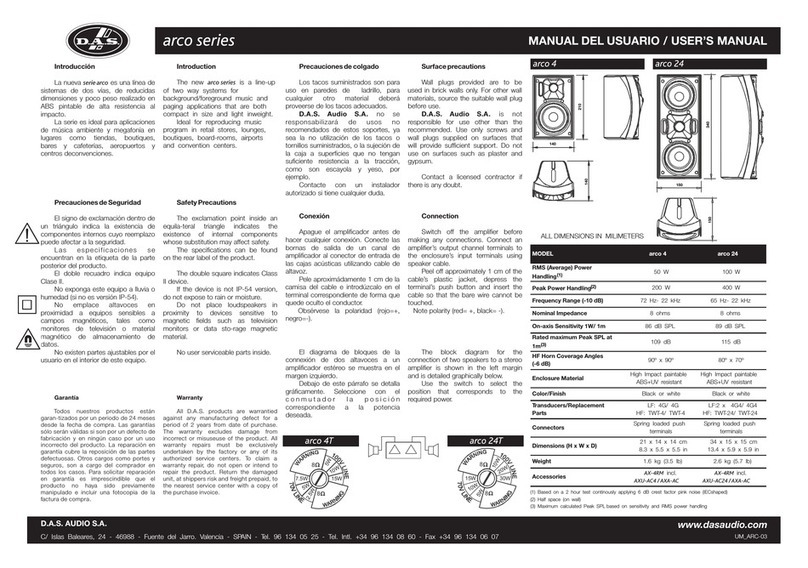
D.A.S.
D.A.S. arco 4 User manual

D.A.S.
D.A.S. Aero 2 Series Quick start guide
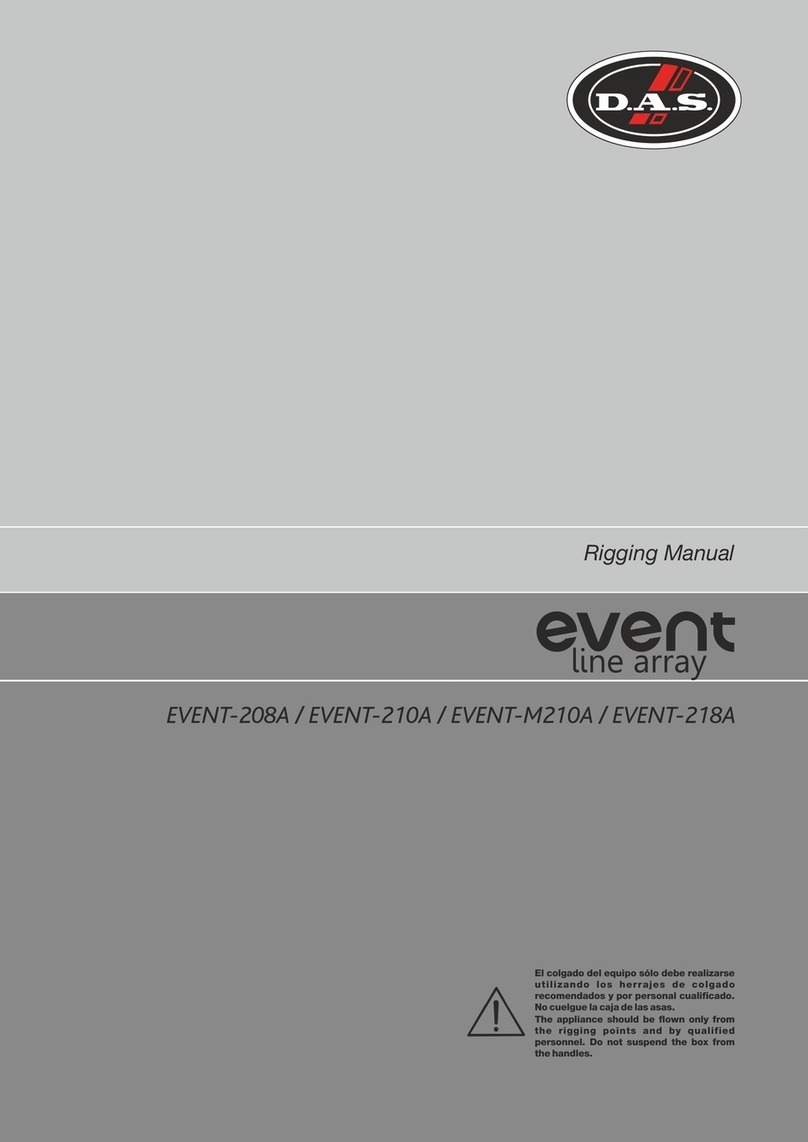
D.A.S.
D.A.S. EVENT-208A Quick start guide

D.A.S.
D.A.S. ARA Series User manual
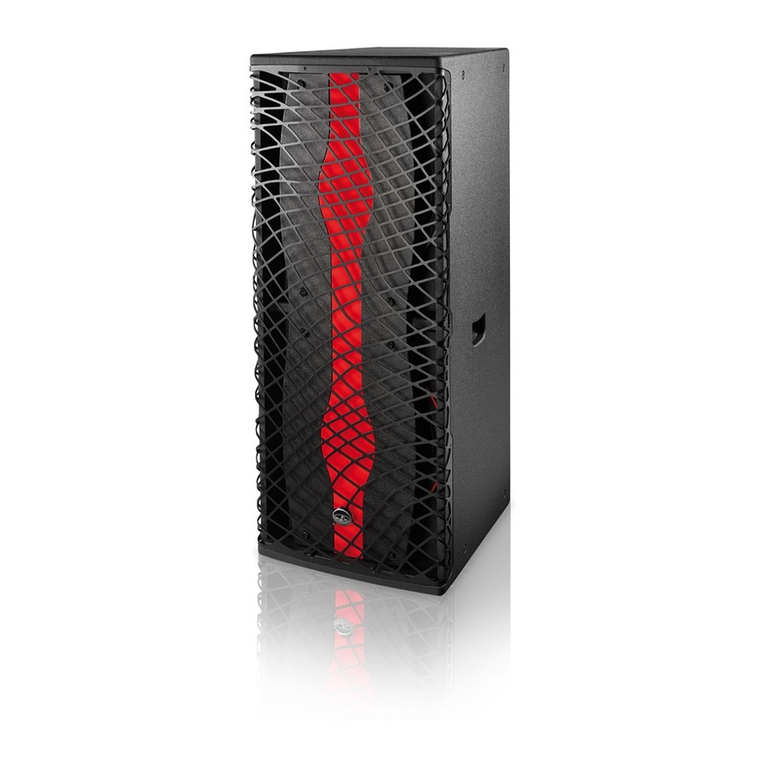
D.A.S.
D.A.S. Sound Force SF-112 User manual
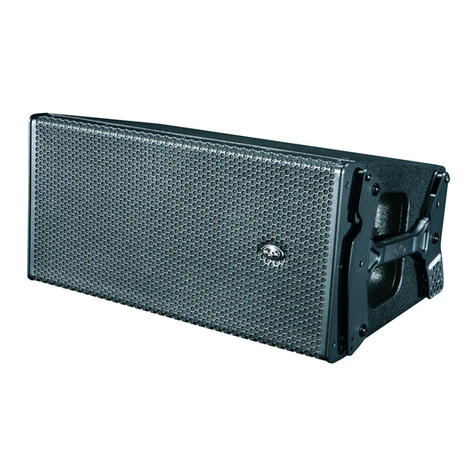
D.A.S.
D.A.S. AERO-12A User manual
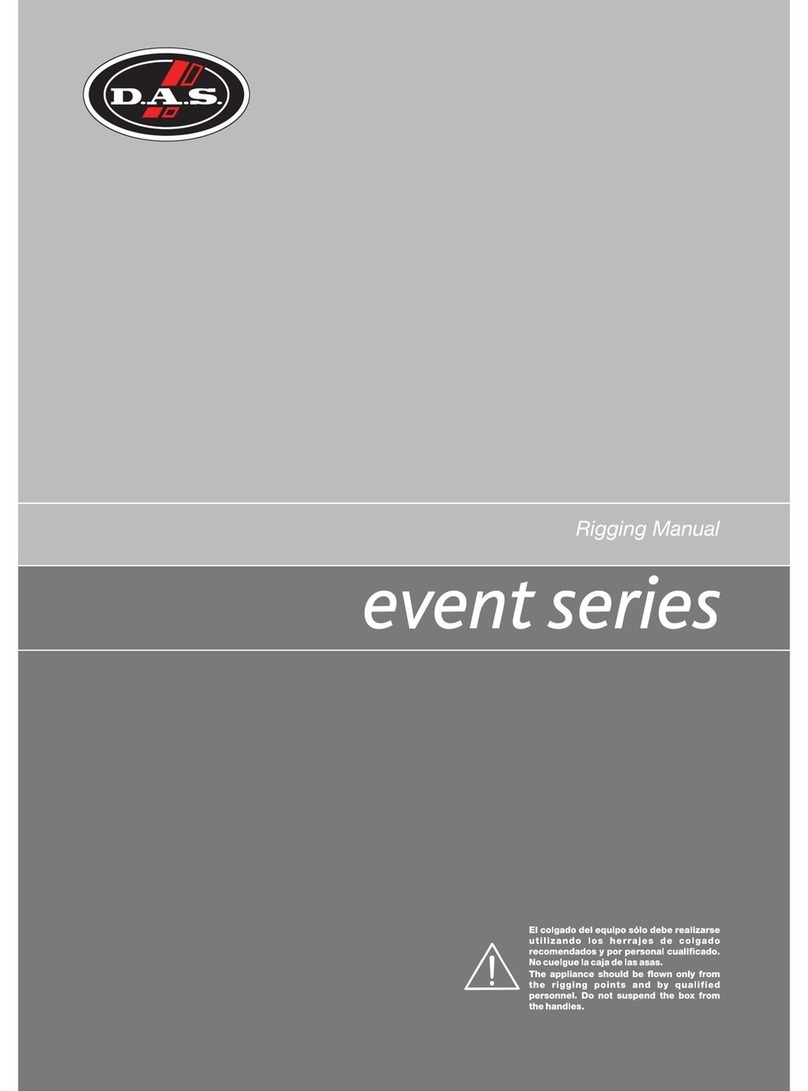
D.A.S.
D.A.S. EVENT SERIES Quick start guide

D.A.S.
D.A.S. EVENT SERIES User manual

D.A.S.
D.A.S. AXS-40UX User manual
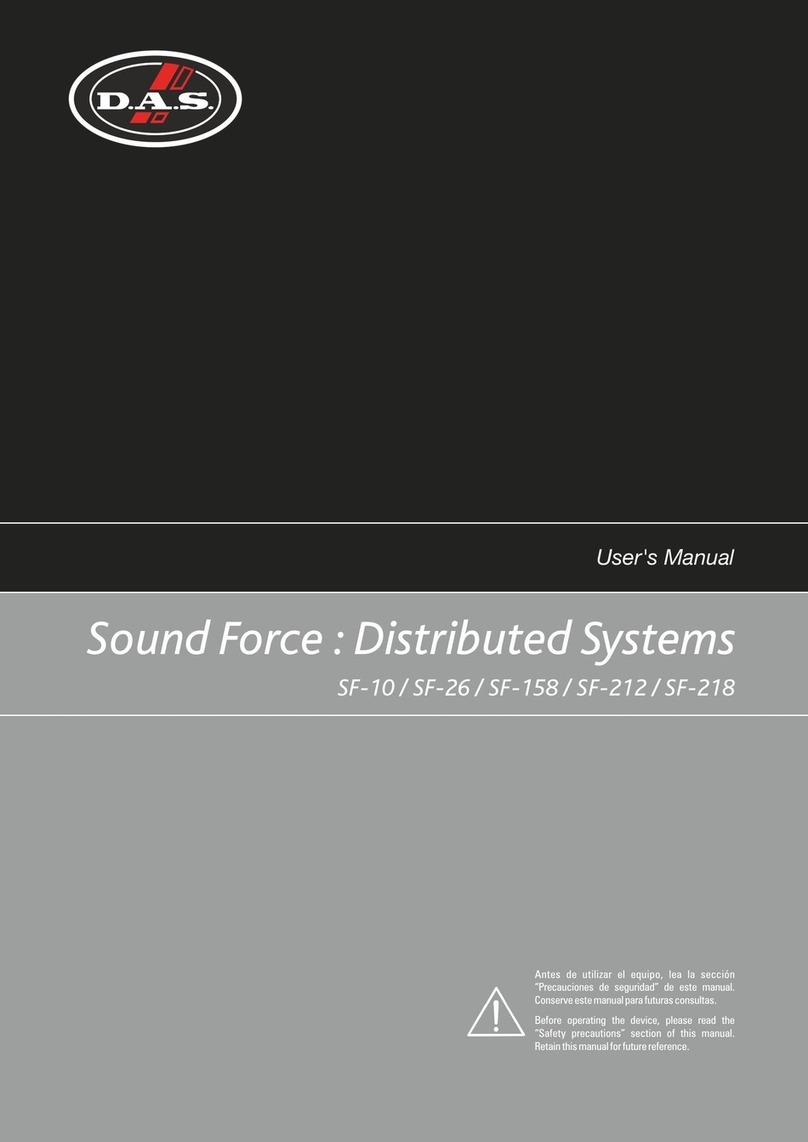
D.A.S.
D.A.S. Sound Froce SF-158 User manual
